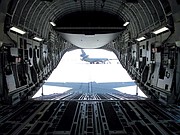Second day of Travis visit reveals hard-working airmen
Herald Columnist | Hagadone News Network | UPDATED 10 years, 4 months AGO
This is the second of a three-part series about an honorary commander visit to Travis Air Force Base.
The wind at Travis Air Force Base, CA is always blowing, at least I didn't experience a calm moment during my visit. We were told this fact is the reason the base was constructed in this exact spot. The wind was important in helping heavy bombers off the ground.
The group of 25 Fairchild AFB Honorary Commanders was at Travis for a two-day informative and educational visit to learn more about the Air Mobility Command mission, including airlift and medical readiness. The goal was for this group of civic leaders to gain a larger Air Force perspective. The goal was accomplished.
We gathered at a conference room of the Air Force Inn on base for a continental breakfast at the beginning of the second day. Guiding a group of people, such as this group of HCs, can be prepared to herding cats, but this was a good and obedient flock. We didn't give 92nd Air Refueling Wing Public Affairs Chief Scott King much trouble. Of course, his knack for being well prepared helped and the coordination between him and the Travis people was superb.
Our first tour of the day was with the Travis portion of the 621 Contingency Response Wing. The other half of this unit is located at Joint Base McGuire-Dix-Lakehurst, NJ.
Inside a large warehouse were several different teams each with different missions to achieve a specific goal. These airmen open forward bases and extends existing Air Mobility Command infrastructure via rapid forward deployment capabilities. They also present core airbase operating forces to war-fighting combatant commanders to meet the nation's National Security requirements.
They employ mission-ready airfield assessment teams, airfield operations, command and control, aerial port, and aircraft maintenance personnel, as well as airlift, weather, medical, intelligence, air traffic control, security forces, finance, fuels, supply and contracting personnel to project and sustain forces worldwide.
A portion of this unit is always on alert. They have all of their equipment packed and ready for deployment to anywhere in the world. The security forces are ready, along with the medical, communication, medical and other teams. This is was an impressive and exciting group of airmen.
The 60th Aerial Port Squadron was our next stop. Imagine an ocean port, but is on the edge of an airport. This is Air Mobility Command's primary west coast aerial port, which supports seven major commands, Department of Homeland Security and all Department of Defense services' air transportation needs.
Their daily mission uses, at one time or another, every major weapon system in AMC, such as C-130, C-5, KC-10, KC-135, and C-17. All of these aircraft were on the flight line awaiting the next mission. The flights provide daily service to Yokota or Osan or both, depending on the cargo awaiting airlift.
This warehouse is a busy place, with forklifts moving pallets around, airmen assembling pallets and others moving pallets on rollers to scales and then to waiting places before being loaded onto aircraft.
Think of an Air Force mechanic needing a wrench, the 60th APS will send her one. If a security force needs a pistol, the 60th will make sure one is shipped. Medical supplies needed in Korea, this unit will get the medicines to the correct place.
Remember, the pallets must be constructed to fit inside the aircraft used for the shipment. Most of the shipments are not square, because the inside of an aircraft is not square.
"Friday is produce day," one of the airmen said.
Every Friday this unit receives and ships tons of fresh produce to points throughout the Pacific. This isn't food which can be shipped anytime, such as Meals Ready to Eat, no, plus this perishable cargo can't sit in the warehouse for days. The fresh produce needs to be checked into the inventory, placed on shipping containers and placed on aircraft in one day.
Luckily, computers help in this day and age. The main warehouse is huge, the outside covered storage area is huge, plus there is an uncovered area in case there is a need for more room.
Next week: The David Grant Medical Center.
ARTICLES BY HERALD COLUMNIST

It began 25 years ago, but who's counting
Feb. 13, 1991 was a special day for me. The first weekly outdoors column began on this day with my name on it. Forgive me, as I puff my chest a bit, but 52 columns a year for 25 years comes out to an even 1,300.

Relocation camp life not all bad for Mae Higashiyama
Bits and Pieces

I'm blaming Papa Joe Wiggs and Ted Nugent
The mission involved hazing pesky elk from certain orchards in an area south of Wenatchee. These critters can cause thousands of dollars worth of damage if not trained to stay away.



